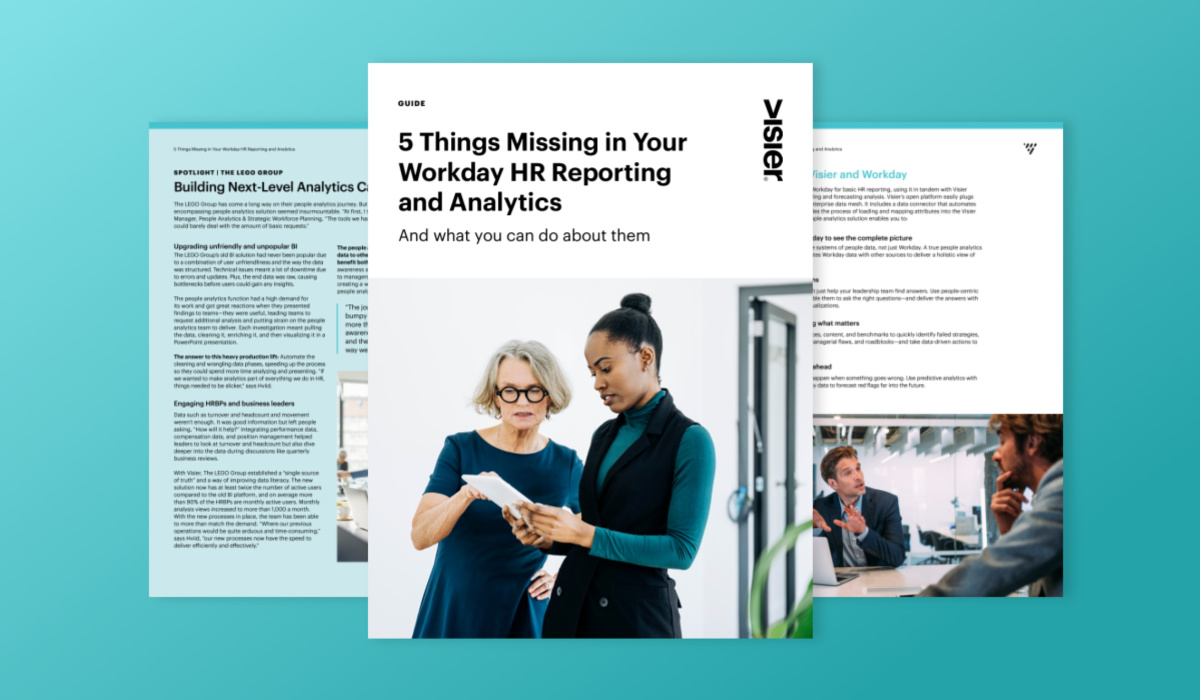CORPORATE REPORTING
Corporate Reporting: What It Is, Best Practices, and Real-world Examples
Corporate reporting helps communicate the value a company creates and its impact on people, the environment, and society. Corporate reports are composed of both financial and non-financial data and are a must-have for any company that aims for transparency, equity, and accountability.
Take a tour
Table of contents
What is corporate reporting?Corporate reporting benefits and challengesHow to get started with corporate reportingExamples of corporate reportingHow to use people analytics for effective corporate reportingWhat is corporate reporting?
Corporate reporting means reporting financial and non-financial data to stakeholders. These reports can take many forms, depending on their goal, including audit reporting, financial reporting, corporate governance and responsibility reporting, and more.
Annual reports provide a general view of company data, and can include people data, financial information, and much more. But you can also take a more narrow and focused approach to corporate reporting with avenues like sustainability reports or financial statements.
These reports do not exclude one another. In most cases, it is better to use more than one type. The true end goal of corporate reporting should always be to communicate the value that a company creates. This includes the impact it has on people, the environment, and society as a whole.
Corporate reporting benefits and challenges
Corporate reporting offers many benefits, such as transparency and improved risk management, but it also has its challenges. Here are the main pros and cons.
Benefits of corporate reporting
1. Increased transparency
Corporate transparency is a win for everyone, especially employees, customers, and stakeholders. It increases trust and accountability and helps everyone improve and make better decisions.
Employees are asking for transparency right from the recruitment process. A Deloitte survey showed that, in 2020 and 2021, Gen Z and Millennial candidates tended to choose jobs based on the company’s ethics.
Once they start working for a company, people want that transparency to continue. Pay transparency is one key priority, but more and more people also want to understand the impact the company they work for is making on social, economic, and environmental causes.
2. Compliance with regulations
Corporate reporting is fundamental to the business, and essential in maintaining strong relationships with shareholders and stakeholders. There are myriad rules and regulations businesses must comply with, and they can vary by region, business size, and more.
In August 2020, the U.S. Securities and Exchange Commission (SEC) adopted a broad set of amendments to the disclosure requirements under Regulation S-K. The expanded human capital disclosure requirements requires companies include human capital resources as a disclosure topic.
In the European Union, the Corporate Sustainability Responsibility Directive (CSRD) became law on November 28, 2022 and covers a wide range of reporting, including a comprehensive set of standard measures that include the key areas of Environment, Social, and Governance (ESG).
3. Improved decision-making processes
Corporate reporting isn’t only about presenting data. It’s also about analyzing it and using it to improve your decision-making processes. Through these reports, you can see what’s working and what isn’t, and find those areas where changes must be made.
4. Improved risk management
Any business comes with risks. The key is knowing what these risks are and how to respond to them. Corporate reporting is an excellent tool for identifying risks and opportunities.
By looking at metrics and benchmarking against the competition and the market at large, you can gain a better understanding of what could go wrong in your business and how to reduce those risks.

Challenges of corporate reporting
1. High complexity and costs
Quality corporate reports take time and resources. If reporting was not on your radar until recently, you need to be prepared to invest quite a bit of time, resources, and money.
Gathering data, analyzing metrics, and creating extensive reports is not something that happens overnight. And the bigger the company, the more data you’ll have. So this will most likely need to be a team effort.
Knowing what and how to report is often a key to success. Recently, many stakeholders have spoken against complex financial reports, for instance, which are often irrelevant to investors.
Understanding what your stakeholders want to see and what the best way to present it is, while also staying compliant with regulations, adds another layer to the already high complexity of corporate reporting.
2. Not enough standardization
The EU’s CSRD makes the first step towards some standardization for corporate reporting. But the journey is still long. If you operate only in the EU, your path forward is fairly clear. But what happens when you operate both in the EU and the US, for instance?
This lack of a global standard can increase the effort needed to create compliant corporate reports. It further adds to their complexity and costs, which makes many companies feel the effort outweighs the benefits.

How to get started with corporate reporting
Corporate reporting may not always be easy, but when done correctly, it will bring immense benefits. The question is where to start. Here are the steps that will put you on the path to successful corporate reports.
1. Know your “why”
What goals are you trying to achieve with your report? Before you start thinking of data, metrics, or other numbers, take some time to define the why.
Aim to make your goals SMART—Specific, Measurable, Achievable, Realistic, and Timely. This will show you exactly what data you need and it will give you an idea of what your corporate report should focus on.
At this stage, you’ll also want to choose the format of the report. Are you creating an annual report, a financial statement, or perhaps a sustainability report? Whatever it is, your goals will help decide the type of report you need.
2. Gather the data
Now that you know the “why,” it’s time to look at the “what”. The data should be accurate, relevant, and up-to-date. Resist the urge to gather more data than you need for your report. While it might not hurt, it can make the process more complicated than needed.

3. Create the report
With the goals and the data at hand, you can start working on the report. Make it comprehensive but easy to understand. The data may be clear to you, but it doesn’t mean it will instantly make sense to all the stakeholders.
Use clear and concise language and don’t run away from things like charts or graphs. These will make your report easier to follow and understand and will help everyone focus on the key points.
4. Review and publish the report
Before publishing your corporate report, ask internal stakeholders to review it. They can help with comments regarding its accuracy, its relevance, but also its clarity. Once it has the management and/or audit team’s approval, you can publish the report.
5. Analyze the reporting process and make improvements
Corporate reports are not something you do once and never think about again. Quite the opposite. They’re regular and ongoing events that are a key component of company stakeholder management. To improve over time, analyze the reporting process. See what went well and what could’ve been better.
How did external stakeholders respond? Did you meet your goal expectations? This analysis will help you improve your reporting process in the future so that you can get the most out of it.

Examples of corporate reporting
Corporate reporting can take various shapes and forms. The best one for your business depends on your goals and any regulations you need to be compliant with. If you’re in the EU, for instance, you’ll need to look at the CSRD’s requirements. Or if your goal is to report on revenue, a simple financial statement might be enough. Here are some examples of corporate reporting.
1. Corporate social responsibility (CSR) reports
The CSRD is bringing these reports into the spotlight, but they’re not new. Until the CSRD, there was no standard format for them. Still, most companies focus on four major aspects: environmental, economic, ethical, and philanthropic.
A great example is CISCO’s 2020 CSR. In it, they discuss how the company is tackling climate change, but also their response to COVID-19, and much more.
In the EU, these reports will now become more complex. For instance, you’ll need to include data related to headcount and FTE reporting and break it down by gender, country, employment type, and more.
2. Annual reports
These are the most common types of corporate reports. They usually contain both financial and non-financial data and offer a general overview of the company’s impact throughout the year.
Not everyone likes annual reports, with many saying they are becoming irrelevant. Their complexity is one of the main reasons. Some feel an annual report needs to contain so much data that they’re hard to analyze. Plus, looking at data once a year may be enough for transparency and accountability. But is an annual review really enough for risk management?
An example of an annual report is CISCO’s 2022 Purpose Report. They start by looking at the financial data and later continue by presenting things like inclusivity and social justice actions. They present their goals and the progress they made throughout the year and later look at future directions.
3. Proxy statements
A proxy statement is a document that publicly traded companies must share with their shareholders before the annual meeting. They often go hand in hand with annual reports, but they’re not the same.
Proxy statements highlight board nominees, information on compensation, and voting. They also provide other information related to the qualifications required for board members, and anything else shareholders must know before voting during the annual meeting.
How to use people analytics for effective corporate reporting
People data is key to effective corporate reporting. The CSRD’s provisions on headcount, annual compensation ratio, and more, make people data and analytics more important than ever. People analytics tools can help you find the people data and key insights you need to create a comprehensive and clear corporate report that is compliant with ESG standards.
Inclusivity and diversity are more important than ever, and reporting on these measures is increasingly important. You can’t create comprehensive corporate reports without including compensation. After all, financial data is almost always part of these reports. Whether that’s through a standalone financial statement or part of an integrated report, financial data is crucial to any corporate report.


